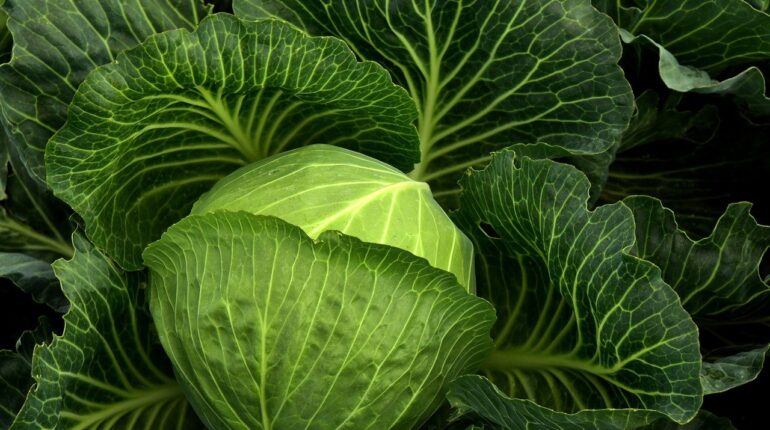Cabbage grows well in a moist climate. In Ghana, it can be grown anywhere. However, commercial cabbage farming is mainly done in Southern Ghana, specifically in Akwapim and Kwahu areas. Cabbage is also cultivated in the moist high elevations around Tarkwa.
Read also: Cucumber Farming In Ghana Is Essential For Your Success – Read This To Find Out Why
In this article, we shall be looking at the kind of soil good for cabbage farming in Ghana, when to irrigate, pest and disease control, weeding, harvesting, and marketability.
TECHNIQUES USED IN CABBAGE PRODUCTION IN GHANA:
- Choose sandy soils rich in organic matter Plant in favorable weather, usually during the rainy season.
- Plant it in the nursery first before going to the main field.
- Use a very good variety as it can make you successful or engaging
- Plant ideal cabbage to harvest faster, ripen faster, and resist diseases/pests.
- Apply fertilizer at each stage of their development, preferably organic manure.
- Harvest early to prevent the leaves from yellowing or wrinkling
Read also: Okra Farming In Ghana – A comprehensive Guide On How To Start Okra Farming In Ghana
Cabbage plant and gaps
- Sow the cabbage seeds 2.5 cm deep at a distance of 2.5 cm; thin plants up to 18 to 24 inches (45 to 61 cm).
- Transplant cabbage in the garden when the plants have 4 to 6 weeks and 4 to 5 true leaves.
- Insert socks or curved stems deep; you can bury 2.5 to 5 inches from the main stem to two sets of upper leaves.
- Space between 18 and 24 inches (45 to 61 cm) between 24 and 36 inches (61 to 91 cm). You can leave the plants closer, but the adult heads will be smaller.
- Plant the cabbage in early spring through black plastic or garden cloth built to warm the soil. Cut x in the material to transplant.
- Plant successive crops every two weeks or plant seeds and transplants at the same time, or plant varieties in the early and mid-season at the same time to harvest at different times.
- Plant 4-8 coals for each member of the household.
Read also: The Super Easy Way To Start Farming At Home – Useful Guide.
What is the best time to grow cabbage?
Cabbage grows best in Spring. Cabbage was washed in cold weather.
Grow the cabbage in the spring to harvest before the summer heat, or start the cabbage in the middle or late summer to harvest on the cool days of autumn, winter, or early spring. Start sowing within 4-6 weeks before the last frost in spring
LAND PREPARATION FOR CABBAGE FARMING IN GHANA
- Cabbage can be grown on any soil, but for it to be the best, it is better to use sand with good compost.
- Get the land and remove it from all unnecessary weeds and shrubs.
- Use a tractor to loosen the soil (for a large farm, otherwise a shovel can be used on a small farm), if the soil is very hard, it can be plowed about 3 times with the third plow. added planting.
- Prepare the bedding for the seedlings by fertilizing with the same amount of soil that organic manure uses.
PLANTING OF CABBAGE:
- Dig a 2-3 cm deep pit and put 2 seeds inside and cover it lightly.
- You can use growers ’bags, bag bags, and surface rubbers to pick up the seedlings.
- Transplant the seedlings to the mainland you use to grow cabbage after 3-4 weeks.
- At this time it should be 14-16 cm tall or when it shows 4-5 leaves.
CABBAGE PLANTING:
- The place should be at a distance of 45 cm, and the rows – 45-60 cm.
- Its gaps also depend on the type of variety being planted.
- Early cabbage lasts 50-70 days, mid-season cabbage lasts 70-90 days, while late – 90-125 days.
- Before planting the crop, the beds should be watered intensively so that there is enough moisture in the soil for the plant to take root.
- Transplant the seedlings in the evening or in cold weather for others to avoid heatstroke
- Soil P.H should be between 6.5-7.5.
- It takes about 5-17 days to sow cabbage, the germination days of different varieties differ.
Read also: How To Make Money Through Farming In Kenya.
IRRIGATION / MULCHING IN THE CABBAGE FARM:
Irrigation should be done regularly, as cabbage requires at least 3.8 cm of water each week. Drip water is strongly recommended.
Cabbage can not withstand drought, so if you can not water the farm, especially not during the rain. Or do not bother to grow cabbage at all during the dry season.
Water it every morning and evening during intense heat.
However, you can choose days to get wet during the rainy season, except that it rains every day.
As the plants mature, stop watering the others to prevent them from bubbling.
Use compost to cover the farm in others to keep the soil moist and prevent excessive water loss.
It will also help control weeds and add nutrients to the soil.
Use of manure/fertilizer:
Cabbage plants are heavy feeders, just like garden eggs and onions, because such manure must be applied at every stage of their development, while the manure type is used carefully at the same time.
The first mist of soil preparation should be heavy (a lot).
After 3 weeks of transplanting, reapply and reapply when you start removing new leaves.
Finally, use manure when you start to develop the heads so that they form well so that they are worn before harvest.
At present, fertilizers should contain more potassium as it is useful in plant derivatives.
PEST / DISEASES OF CABBAGE
The simplest pesticides are cabbage white, flea beetles, larvae, imported cabbage worms, loops, and more.
Read also: How To Keep Rat Away From Tomato Plants – An Incredible Easy Method That Works For All
Although the most common diseases are Fusarium jaundice, hip root, blackhead, rot; a fungal disease that accumulates in the soil.
SOLUTION; Plant-resistant variety and practice crop rotation.
Dissolution; can happen after a strong embankment or when irrigation is done immediately after severe drought stress.
To save the situation, with a shovel cut the roots about 25 cm on one side about 25 cm to the ground.
Another cause of decomposition is when they are overcrowded, thus giving a good distance to the plant.
VARIETIES OF CABBAGE
There are seven varieties of cabbage. Even though some are not common in Ghana and other countries but for educational purposes, I have lost them.
-
Cannonball cabbage
Cannon cabbage, commonly called kale, is one of the most popular cabbage varieties. It is so named because of the way the leaves rotate stiffly, compactly on each other; with a final product similar to a cannonball
-
Bok Choy
You may know it as bok choy, bai cai, or pak choi but they all mean the same thing: a dark, leafy vegetable with slender stems that are more reminiscent of Swiss chard or spinach than it is a cannonball cabbage.
-
Choy Sum
You may know it as choy sum or can xin, depending on your mother tongue; in which, the Cantonese and Mandarin transliteration of its name is “heart of the vegetable”. The leafy veggie appears similar to kai plan and its Chinese cabbage sibling, bok choy, but can be easily recognized by the distinctive yellow flowers it bears.
-
Napa Cabbage
Oblong in shape with frilly, yellow-green leaves, this cabbage variety is sweeter and softer than the other varieties and is widely used in East Asian cuisine.
-
Savoy Cabbage
Probably the most photogenic of the cabbages is this lacy variant. The leaves of the savoy cabbage are more loosely layered and less tightly packed than green or red cabbage, which gives it shorter shelf life.
-
January King Cabbage
Don’t confuse this purple-green beauty with the red cabbage. The colors on this curly-leafed vegetable differ from head to head and can range from deep, royal purples to cool crisp turquoises. And as its name suggests, the cabbage is a hardy vegetable that’s usually planted in autumn and harvested in winter.
-
Red Cabbage
Also known as the purple cabbage or red kraut, the red cabbage changes its color according to the pH value of the soil it grows in – the leaves grow reddish in acidic soil and more purplish in neutral – acting as a litmus test of sorts
HARVESTING
Cabbages are picked when they mature for other adults to stay in storage longer.
It’s not like peppers, aubergines, and tomatoes that can be harvested before they form.
It is ready for harvest in about 2-5 months.
The yield depends on the variety, but 70-80 tonnes or more per hectare can be obtained if all agronomic conditions are fully met.
Harvest when ripe and firm heads. Or if the heads are wrapped and the leaves are wrapped, still fine.
You can squeeze the fruit by hand to know if it is strong; the free and soft head has not yet matured.
If you allow the leaves to turn yellow or stain, they may not stay in storage for long.
Use a knife to cut the head off the base of the plant and leave about 3 leaves to protect the head from bruising, scratches, or any damage.
The remaining stem of the soil, like lettuce and water leaves, will continue to develop as you continue to combine it.
Before harvesting, wash it in others to remove insects and dirt.
MARKETING:
Find men and women in the market and sell to them.
Let the people around you know you’re growing cabbage and you’ll see that they go down to buy it themselves.
Sell to salad shops, supermarkets, and supermarkets that sell food, hotels, restaurants, and more.
Advertise in online stores to sell more.




I want to be a carbbage farmer, is there any way you can help
Thanks for the education I’m very happy I can now start my cabbage farming.
It’s very useful
I want to be a cabbage farmers , is there any way you can help me
Thanks, Peter.
Please where is your location?
This year I have started farming cabbage I need more knowledge about it
Help me out with this farming
Please I need some ideas about cabbage farming